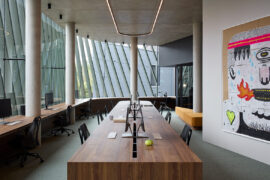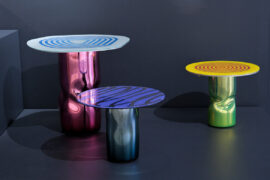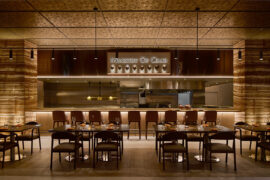Design and research studio Space Popular explores the experiential qualities of glass with architectural surfaces becoming a simulated virtual reality.
Glass offers a window to the real world, but what if it was potentially a window into a simulated virtual world? This was the premise of Space Popular’s recent exhibition The Glass Chain at Werkstatt in London, where the studio encouraged visitors to imagine a new purpose for glass in building design.
Lara Lesmes and Fredrik Hellberg established Space Popular in 2013 after graduating from the Architectural Association in London and moving to Bangkok to teach and practice. Their work is driven by the design of experiences using systems rather than buildings, and their cross-disciplinary approach has seen them create a diverse body of work including ceremonial spaces, highways, virtual platforms, religious buildings and music stages, as well as clothing, furniture and brands. “This diversity is what best represents us. We constantly remind ourselves of the two statements contained in our logo: ‘all things’ and ‘all places’,” the pair explain.
For The Glass Chain, Lara and Fredrik explored an alternative future for glass in architecture inspired by the legacy of The Glass Chain correspondence between architects from 1919 to 1920. Initiated by Bruno Taut, the architects exchanged utopian ideas that formed a basis of expressionist architecture in Germany.
“The visionary architects of German expressionism in the early-twentieth century imagined entire worlds built in coloured glass that, through sheer beauty and ingenuity, would inspire productive and healthy societies to form and flourish,” Lara says.
Finding relevance in this work today, Fredrik and Lara explored the potential experiential qualities in glass as a window to the virtual world. “Screens are getting bigger and cheaper, phones are getting smarter and virtual reality devices are getting less intrusive. We will have to prepare ourselves for a world where every human-made surface is potentially a window into a simulated virtual world, and where glass is no longer the non-material that truthfully shows you the world beyond it, but the surface of ultimate deception that can bring you anywhere you want to go,” Fredrik explains.
The exhibition featured a kaleidoscopic glass construction that played with visual perception: glass doorways as grand arches and small steps as giant pediments. The fantastical setting was initially built as a virtual 3D model comprising different textures, patterns and colours, then flattened and printed on sheets of StoVentec Glass to create a tactile and illusory environment for visitors.
Common throughout Space Popular’s work is a focus on the human experience; “an understanding that the human mind is the ultimate site,” the pair describe. They launched their academic research branch Tools for Architecture in 2016, exploring experience-driven design methods.

The Glass Chain exhibition by Space Poplar explores glass as a future window into digital lives, photo by Ben Blossom.
This year Space Popular is presenting a new timber building system, developed in collaboration with the Swedish wood industry, at the 16th Venice Architecture Biennale. An exhibition investigating anthropomorphism in architecture in the age of artificial intelligence opens in April at MAGAZIN gallery in Vienna, and construction of Space Popular’s first house begins in Valencia, Spain.
Space Popular will be presenting at the Paper Architecture workshop at Melbourne School of Design, held from 25 June to 6 July 2018. The workshop explores how architecture can be experienced when it is not physically built.
INDESIGN is on instagram
Follow @indesignlive
A searchable and comprehensive guide for specifying leading products and their suppliers
Keep up to date with the latest and greatest from our industry BFF's!

Sydney’s newest design concept store, HOW WE LIVE, explores the overlap between home and workplace – with a Surry Hills pop-up from Friday 28th November.

From the spark of an idea on the page to the launch of new pieces in a showroom is a journey every aspiring industrial and furnishing designer imagines making.

Smart Design Studio and Those Architects combine landmark and workplace in Bundarra, a Surry Hills gateway blending old and new.

Despite its long and rich history, signwriting is a profession in decline. Will Lynes’ new show, Oily Water at Canberra Glassworks, aims to showcase the techniques of the trade to highlight its potential in design.
The internet never sleeps! Here's the stuff you might have missed

After more than two decades at Architects EAT, Eid Goh launches AIR, a new Melbourne-based studio focused on adaptive reuse, hospitality and human-centred design across commercial and civic projects.

At the Munarra Centre for Regional Excellence on Yorta Yorta Country in Victoria, ARM Architecture and Milliken use PrintWorks™ technology to translate First Nations narratives into a layered, community-led floorscape.